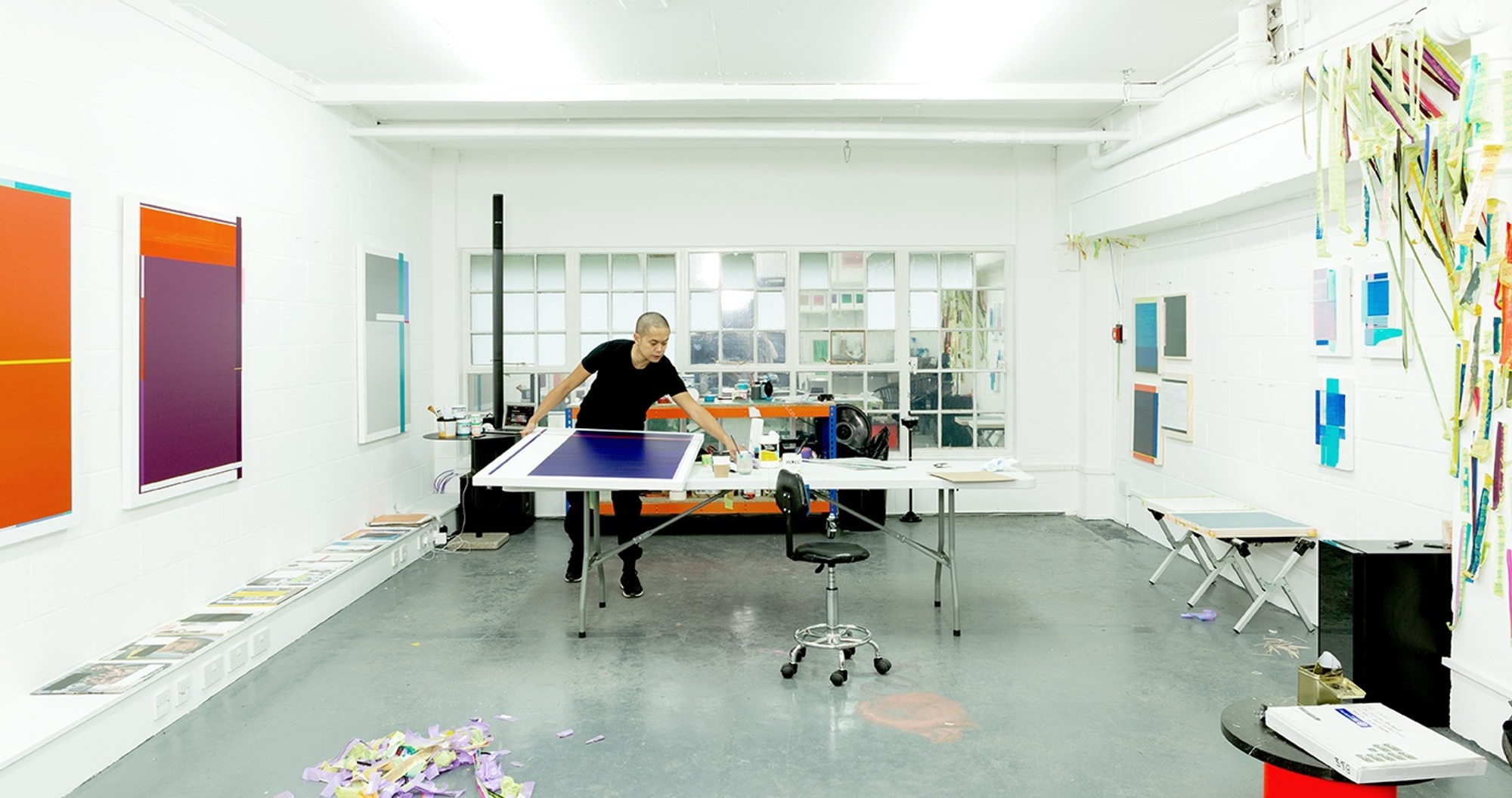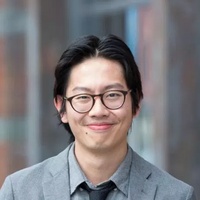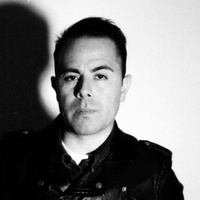As told to Ken Tan, 1457 words.
Tags: Art, Process, Beginnings, First attempts, Creative anxiety, Mental health.
On the challenges and joys of being an artist
Visual artist Ash Ghazali discusses what led him to leave behind a career in advertising to become a painter, setting up a studio, and why he's impervious to criticism.You’ve been in advertising for many years. Why become an artist now?
I have been in advertising for 17 fucking years. The career started in Singapore and brought me into London, where I am based now. I wanted to be a musician, but you can’t make a living as one in Singapore, unlike advertising. I have since worked as a creative director for some of the best agencies in the world: Wieden+Kennedy, BBH, Grey London. I am grateful to have worked with them, but I never felt creatively satisfied. In fact, the higher up the ladder I went, the worse it got.
When I came to London, it reached a point where I desperately needed to save my creative soul. That’s when I started painting.
Were you collecting art then?
I acquired some pieces, but I wouldn’t say I’m a collector. At that time, I literally felt like painting. I bought materials and jumped in. I still had my day job, but each day I would come home and paint. I painted my sorrows away…
Did something happen?
There were a couple of things. It got extremely stressful at work and I suffered a nervous breakdown. Then I had a divorce. When I was painting, I didn’t think about any of those things. To add insult to injury, the last company I was in wasn’t doing so well, or so they said. They had to let me go. That was a turning point for me.
I asked myself, “What do I do now?” I could find another advertising job, but reflecting on what mattered to me, I felt I couldn’t do anything else but make art.
When did you decide it felt right to accept that you were an artist?
I’m committed to it, so maybe that’s acceptance. When I understood I couldn’t do anything else, I accepted it.
What was the process of finding and setting up your studio space?
I was using my apartment as a makeshift studio. From three canvases, it quickly became 50. Moreover, the canvases got bigger and bigger—it just got impossible to work in that space.
Yet, I never set out to look for a studio. I was lucky. It was only when an artist friend, Gideon Rubin, told me his neighbor was looking to rent her studio that I seriously considered it. The space was a mess, but I took it immediately. I had to put in a lot of work, and money: 5,000 quid to gut and paint the entire space white. And within a month, I moved in and started working.
To add some context, the studio is situated in a council estate, a neighborhood that is still pretty rough. I came to the studio one morning to discover that someone had tried to break in. The perpetrator(s) rammed the door and smashed it through. Thank god the padlocks held. It just costs more money to fix these things. Gideon saw and said, “The painting gods are testing you.”
A couple of days later, even before I fixed the door, they tried to break in again. It didn’t deter me. I’ve since installed a rolling metal gate.
What’s the difference now that you have a studio?
What was nice about having a new studio was that the studio itself was a blank canvas. I felt free. I could see the work clearly in this abstract space. I could experiment more, and each time an idea popped into my head I could easily try it out. I didn’t feel constrained.
 Studio
Studio
What’s a typical day like for you? Do you go to the studio every day?
I go to the studio every day. In the mornings, I prepare my lunch and bring it in a tupperware, which saves me time and money.
When I get to the studio it’s late morning. I’ll have several things I’m working on lined up on the walls. Sort of like a factory line where I focus on the first thing to decide what to do next. I focus on one task a day per canvas, literally, one move a day. When I’m done with a canvas, I move on to the next and so on, until about 10pm. By then, I would have gone through all the items I needed to work through for that day.
Then I leave. As much as I like being in that space working, I need that time away from it to actually assess what to do next. I try not to do too much in a day.
So how do you work out your ideas? Where do you get your inspiration from?
I’m more interested in the process of making rather than the finished product. The hands-on working out of ideas. I don’t actually know how it will end. It’s probably something ingrained in me from my years of making music and advertising. You go down this rabbit hole of creating or coming up with ideas, and as you’re doing it, the process inspires you to come up with other things, by pure chance.
My interests are in music, fashion, and art, which I’ve consumed all my life. I think obviously these have something to do with my work now, but it’s never been contrived. I don’t brainstorm next steps, that is extremely contrived for me. That’s something you do a lot of in advertising, where you sit down and cook up as many ideas as creatively possible, then pick the unanimous best one. What I love about what I am doing now is allowing creativity to happen organically.
So painting is almost like being anti-advertising, anti-planning.
Definitely. To me, advertising is about a prescription: producing a prescribed solution to someone else’s prescribed problem. Painting was my creative escape.
You were involved in many creative roles in your life: a music producer, a DJ, advertising. Do you think it’s important to have these varied experiences?
Without them, I would never have reached the art I do now. People ask me now where I studied art, and my reply is, “The School of Life, 43 years in the studio of life is where I studied art.”
I’ve been DJing and making music for 20 years, and music has always been a very private affair, where I’m just creating for myself. I’m comfortable with expressing what I love rather than expressing what I think other people would like.
What I loved about advertising was the rigor of just hunkering down and focusing on creating. Also the professionalism of dealing with people, and of presenting myself and my work.
And how do you deal with failure?
I’m so used to getting shot down every day that I’ve become bulletproof. Naturally, criticism hurts personally, but I’ve learned how to deal with it. When I had my first exhibition earlier this year, I didn’t have a single ounce of fear of what people would think of my work. But when they did enjoy it, I was grateful. That definitely came from advertising.
How do you feel music has influenced the aesthetics of your work?
Album cover artwork, hip hop in particular, definitely was a big influence. I was shaped by the graphics of hip hop: Def Jam, EPMD… their logos and bold colors. I loved sneakers and how they looked.
I like my art to be effective with as few things as possible. Not that it is minimal, no, but more about knowing when to stop adding elements. Questions I constantly ask myself: What is the relationship between the materials and colors? Where do I place it? What is the space in between two things?
For example, I am now working on a series of paintings where I cut, fold, and layer different types of fabric and fragments of painted canvases. It’s a constant negotiation of the senses. What’s the balance? I like to tread that line where a step further is too much, but a step too soon doesn’t add that last punch. I love the little details.
How do you fight burnout?
I take my time. I don’t rush. I really take my time. In fact, when I go into the studio, I don’t paint right away. I’ll make tea, sit down, and look at what’s on the walls. It sounds cheesy, but I let my subconscious lead. Sometimes I’m doing some other task entirely, like stretching canvases. For me, creativity should happen organically.
Ash Ghazali recommends:
- Kim Lim Turnbull
- Ida Restaurant London
- Samurai Ramen
- Mulatu Astatke
- Rubble by Pearson Sound




